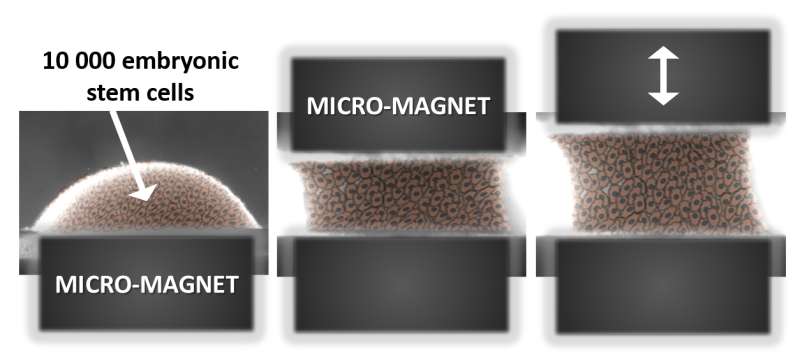Magnetic cellular Legos for the regenerative medicine of the future

By incorporating magnetic nanoparticles in cells and developing a system using miniaturized magnets, researchers at the Laboratoire Matière et Systèmes Complexes (CNRS/Université Paris Diderot) and collaborators have created cellular magnetic Legos. They were able to aggregate cells using only magnets and without an external supporting matrix. The cells then formed a tissue that can be deformed at will. This approach, which is detailed in Nature Communications, could prove to be a powerful tool for biophysical studies, as well as the regenerative medicine of tomorrow.
Nanotechnology has quickly swept across the medical field with unprecedented solutions at the furthest limits of current treatments, thereby becoming central to diagnosis and therapy, notably for the regeneration of tissue. A current challenge for regenerative medicine is to create a cohesive and organized cellular assembly without using an external supporting matrix. This is a particularly substantial challenge when it involves synthesizing thick and/or large-sized tissue, or when these tissues must be stimulated like their in vivo counterparts (such as cardiac tissue or cartilage) in order to improve their functionality.
The researchers met this challenge by using magnetism to assemble, organize and stimulate them. Cells, which are the building blocks of tissue, are thus magnetized in advance through the incorporation of magnetic nanoparticles, thus becoming true cellular magnetic Legos that can be moved and stacked using external magnets. In this new system, which acts as a magnetic tissue stretcher, the magnetized cells are trapped on a micromagnet, before a second, mobile magnet traps the aggregate formed by the cells. The movement of the two magnets can stretch or compress the resulting tissue at will.
Researchers first used embryonic stem cells to test their system. They began by showing that the incorporation of nanoparticles had no impact on either the functioning of the stem cell or its capacity for differentiation. These functional magnetic stem cells were then tested in the stretcher, in which they remarkably differentiated toward cardiac cell precursors when stimulation produced "magnetic beating" that imitated the contraction of the heart. These results demonstrate the role that purely mechanical factors can play in cell differentiation.
This "all-in-one" approach, which makes it possible to build and manipulate tissue within the same system, could thus prove to be a powerful tool both for biophysical studies and tissue engineering.
More information: Vicard Du et al, A 3D magnetic tissue stretcher for remote mechanical control of embryonic stem cell differentiation, Nature Communications (2017). DOI: 10.1038/s41467-017-00543-2




















